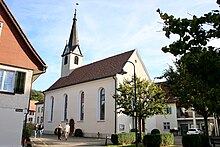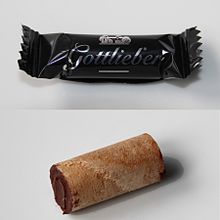Love God
| Love God | |
|---|---|
| State : |
|
| Canton : |
|
| District : | Kreuzlingen |
| BFS no. : | 4651 |
| Postal code : | 8274 |
| Coordinates : | 727324 / 280 671 |
| Height : | 400 m above sea level M. |
| Height range : | 395–400 m above sea level M. |
| Area : | 0.31 km² |
| Residents: | 340 (December 31, 2018) |
| Population density : | 1097 inhabitants per km² |
| Website: | www.gottlieben.ch |
|
View from the opposite bank of the Rhine to Gottlieben |
|
| Location of the municipality | |
Gottlieben is a municipality and a town in the district of Kreuzlingen in the canton of Thurgau in Switzerland . From 1798 to 1874 Gottlieben was the main town in today's Kreuzlingen district . Until 2002, Gottlieben was a unified church .
geography
The urban-looking small settlement is 400 m above sea level. M. northwest of Kreuzlingen on the left bank of the Seerhein , which takes in the village stream here . With 340 inhabitants and 32.42 hectares, the municipality is the smallest municipality in terms of population and area in the canton of Thurgau. Together with the municipalities of Kaiserstuhl and Rivaz , also with 32 hectares, Gottlieben is one of the smallest municipalities in Switzerland.
history
Gottlieb was first mentioned as Gotiliubon at the end of the 10th century . In Gottlieb, originally located in the Bischofshöri , Bishop Eberhard II von Waldburg built Gottlieben Castle in 1251 , which served as the residence of the Bishops of Constance . In 1355 Gottlieben was attacked and burned down by Konrad von Homburg. At the time of the Council of Constance in 1415, the reformer Johannes Hus and the deposed Pope Johannes XXIII sat tied up in a wooden log house on the western castle tower in Gottlieben. After the Swabian War in 1499, the episcopal superior bailiff administered the Gottlieben, Engwilen , Siegershausen and Tägerwilen lower courts from the castle and Schloss Gottlieben until 1798 , which together formed the episcopal Constance bailiff. In 1526 the bishop left Gottlieben and built his residence in Meersburg . During the Thirty Years War , the Swedish Field Marshal Gustaf Horn set up his headquarters in Gottlieben in the fight against Constance . On February 24, 1692, three houses sank into the Rhine in a storm. In 1808 the Gottlieben Castle came into private ownership; In 1837 the complex was redesigned in the neo-Gothic style . The administrations of the spatially identical local and municipal community Gottlieben were merged in 1870 to form a unitary community of Gottlieben.
Originally, Gottlieben was in the parish of Tägerwilen. During the Reformation in 1529, the whole congregation converted to the new faith. The church was built from 1734 to 1735 and the reformed parish of Gottlieben was formed, which has been associated with Tägerwilen since 1912.
In the 17th and 18th centuries, Gottlieben experienced an economic boom as a trading and transshipment center, especially for salt, iron and wine, due to its favorable traffic location on the Rhine. In 1678 Gottlieben received market rights . Although smaller industries settled in Gottlieben as early as the 19th century (button factory, horsehair spinning), fishing, handicrafts and trade were the main livelihoods of the population until the middle of the 20th century. Tourism developed after 1945, so that today, in addition to two boatyards and the well-known Hüppenbäckerei, the gastronomy in Gottlieben is the most important employer. In 2000, the Bodman House , the former home of the poet Emanuel von Bodman , was opened as a memorial and cultural site.
coat of arms
Blazon : A continuous white cross in black .
The coat of arms refers to the Bishop of Konstanz , who founded Gottlieben in the 13th century. Until 1798, Gottlieben was the seat of the episcopal superior bailiff. Since 1959, the community of Gottlieben has been using the old coat of arms in a new drawing as the community coat of arms, which has been in use since 1869 at the latest and which has also been affixed to the ceiling in the meeting room of the government council in Frauenfeld.
population
 |
| year | 1850 | 1900 | 1941 | 1950 | 1970 | 1980 | 2000 | 2010 | 2018 |
| Residents | 385 | 412 | 558 | 739 | 251 | 284 | 304 | 307 | 337 |
Of the total of 337 inhabitants in the community of Gottlieben in 2018, 133 or 39.5% were foreign nationals. 126 (37.4%) were Protestant Reformed and 101 (29.10%) were Roman Catholic.
Gottlieber artist colony
At the end of the 19th and beginning of the 20th century there was an artist colony in Gottlieben, initiated by the writer Emanuel von Bodman (1874–1946) and the writer, painter and sculptor Heinrich Ernst Kromer (1866–1948). There was a lively exchange with cultural workers at the turn of the century such as Richard Dehmel , René Schickele , Wilhelm von Scholz , Rainer Maria Rilke , Ludwig Finckh , Ludwig Klages and Hermann Hesse , and later also Thomas Mann .
Economy and tourism
In 2016 Gottlieben offered work to 104 people (converted to full-time positions). Of these, 36.6% worked in industry, trade and construction and 63.4% in the service sector. There are no jobs in agriculture and forestry.
There is a bakery in Gottlieben , whose Gottlieber Hüppen (filled wafer rolls ) are an internationally known pastry specialty . There are also two boatyards as well as hotels and restaurants. The location of the municipality on the shipping line and the picturesque townscape, which is characterized by half-timbered houses , make the municipality a popular tourist destination, especially in the summer months. Gottlieben is the stop of the Untersee and Rhein shipping company .
Attractions
Gottlieben is listed in the inventory of places worth protecting in Switzerland .
- The gottlieben castle was built by the Bishop of Constance Eberhard II in 1251 and was designed by the singer Lisa della Casa inhabited until her death 2012th
- The Bodman House ( Thurgau Bodman Foundation )
Personalities
- Robert Hallum († 1417), Chancellor of Oxford University 1403–05, Bishop of Salisbury 1407–17
- Johann Conrad Hippenmeyer (1752–1832), founder and director of the Austrian National Bank
- Johannes Hippenmeyer (1779–1854), officer, Thurgau Cantonal Councilor from 1815 to 1831, owner of Gottlieben Castle
- Moritz Roth (1839–1914), Swiss pathologist
- Wilhelm Hummel (1872–1939), Swiss painter
- Lisa della Casa (1919–2012), opera singer, owner of Schloss Gottlieben
- Robert Holzach (1922–2009), banker (SBG), honorary citizen of Gottlieben (1999)
- Franz Oexle (1922–2018), German journalist and editor-in-chief of Südkurier , lived in Gottlieben
- Udo Jürgens (1934–2014), Austrian composer, pianist and singer, had a second home in Gottlieben and died while walking on the lake promenade
- Joachim Eder (* 1951), Member of the Government of the Canton of Zug, Council of States for the Canton of Zug
- Cécile Hummel (* 1962), Swiss painter and artist
- Timo Glock (* 1982), German Formula 1 driver
- Thomas Luckmann (1927–2016), German-American sociologist; lived in Gottlieben from 1983
literature
- Ernst Herdi : Gottlieben. A focal point of historical events. In: Thurgauer Jahrbuch , Vol. 24, 1949, pp. 3–13 ( e-periodica.ch )
- Hermann Strauss: Gottlieben on the Rhine and Untersee. , in: Contributions to the local history of the Kreuzlingen district, issue 13, 1959
- Hermann Strauss: The “weighing house” in Gottlieben. , in: Contributions to the local history of Kreuzlingen, issue 5, 1952
- Esther Bächer: Emanuel von Bodman and the Gottlieber artists' colony 1902–1905 , Huber Frauenfeld 2000, ISBN 3-7193-1208-9
- Esther Bächer: Gottlieben. History information. , Bodan AG Kreuzlingen 2001, ISBN 3-9522278-0-3
- Palaces and castles on Lake Constance. Vol III. South. From Risegg to Gottlieben , Biberacher Verlagsdruckerei 2002, ISBN 3-933614-12-0
- Esther Bächer, Barbara Stark: Missed, forgotten: the painter, writer and sculptor Heinrich Ernst Kromer. A cross-border retrospective , Huber Frauenfeld 2004, ISBN 3-7193-1356-5
- Heinz Bothien: Napoleon's vows of love and other delicacies from Queen Hortense's court libraries. Exhibition catalog number 4 of the Bodman House in Gottlieben , Huber Frauenfeld 2005, ISBN 3-7193-1313-1
- Regine Abegg, Peter Erni, Alfons Raimann: The art monuments of the canton of Thurgau, Volume VIII: Around Kreuzlingen. (= Art Monuments of Switzerland. Volume 125). Edited by the Society for Swiss Art History GSK. Bern 2014, ISBN 978-3-03797-116-1 , pp. 174-215.
Web links
- Official website of the Gottlieben community
- Historical tour - Gottlieben
- Schloss Gottlieben Pictures on swisscastles.ch
Individual evidence
- ↑ Permanent and non-permanent resident population by year, canton, district, municipality, population type and gender (permanent resident population). In: bfs. admin.ch . Federal Statistical Office (FSO), August 31, 2019, accessed on December 22, 2019 .
- ↑ a b Thurgau in figures 2019 . On the website of the Statistical Office of the Canton of Thurgau (PDF file; 1.8 MB), accessed on April 28, 2020.
- ↑ a b Localities and their resident population. Edition 2019 . On the website of the Statistical Office of the Canton of Thurgau (Excel table; 0.1 MB), accessed on April 28, 2020.
-
↑ a b c d e f Verena Rothenbühler: Gottlieben. In: Historical Lexicon of Switzerland .
These sections are largely based on the entry in the Historical Lexicon of Switzerland (HLS), which, according to the HLS's usage information, is under the Creative Commons license - Attribution - Share under the same conditions 4.0 International (CC BY-SA 4.0). - ↑ a b c municipal coat of arms . On the website of the State Archives of the Canton of Thurgau, accessed on December 8, 2019
- ↑ a b History and Stories . On the website of the Gottlieben community, accessed on December 1, 2019
- ↑ a b Population development of the municipalities. Canton Thurgau, 1850–2000 and resident population of the municipalities and change from the previous year. Canton of Thurgau, 1990–2018. On the website of the Statistical Office of the Canton of Thurgau (Excel tables; 0.1 MB each), accessed on April 28, 2020.
- ↑ Internet presence of Gottlieber Specialties AG , accessed on May 18, 2016













